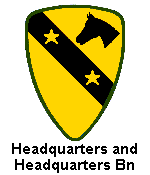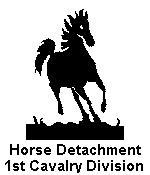

Horse Cavalry Detachment
Historical Missions
"Charge !!"

![]()
 Today's Cavalry
Today's Cavalry




![]()
|
|---|
![]() The garrison, workshops and stables are located in a rural setting adjacent to
the main entrance of Fort Hood. The detachment is organized and equipped to
represent the division as an 1870 era "horse soldier" troop, complete with
cavalry uniforms consisting of government issue blouses, trousers, hats, belts
and boots, authentic firearms, sabers, saddles and work details of the
period. The standard weapons issued to the troops are the 1875 Model 45-70
Springfield "Trap Door" Carbine, the 1875 Colt Single Action, 45 Caliber
Revolver and the 1860 Light Cavalry Saber which was considered as standard
issue for the Civil War period. Saddles used on the horses are the McClellan
1885 Saddle, which has been modified with the 1904 quarterstrap.
The garrison, workshops and stables are located in a rural setting adjacent to
the main entrance of Fort Hood. The detachment is organized and equipped to
represent the division as an 1870 era "horse soldier" troop, complete with
cavalry uniforms consisting of government issue blouses, trousers, hats, belts
and boots, authentic firearms, sabers, saddles and work details of the
period. The standard weapons issued to the troops are the 1875 Model 45-70
Springfield "Trap Door" Carbine, the 1875 Colt Single Action, 45 Caliber
Revolver and the 1860 Light Cavalry Saber which was considered as standard
issue for the Civil War period. Saddles used on the horses are the McClellan
1885 Saddle, which has been modified with the 1904 quarterstrap.
![]() The close order mounted drills are pattered as in the 1883 Manual of
Cavalry Tactics. Even the horses chosen for platoon mounts are selected to
the same physical standards imposed a centry ago. Each horse must be no less
than 15 hands high, and it must be dark, with a minimum of white markings. In
addition to the horses and mules, the platoon has a Studebaker escort wagon,
from the 1890s, which has been restored by members. The wagon was originally
used to haul supplies, but it is now mostly used to give rides to children
attending the horse platoon shows.
The close order mounted drills are pattered as in the 1883 Manual of
Cavalry Tactics. Even the horses chosen for platoon mounts are selected to
the same physical standards imposed a centry ago. Each horse must be no less
than 15 hands high, and it must be dark, with a minimum of white markings. In
addition to the horses and mules, the platoon has a Studebaker escort wagon,
from the 1890s, which has been restored by members. The wagon was originally
used to haul supplies, but it is now mostly used to give rides to children
attending the horse platoon shows.
|
|---|
![]() The detachment operates as a self sufficient unit, performing all of its
specialized functional support. The leather shop is equipped with the hand
tools and special machinery which is required to meet the needs of tack repair
and remanufacture, saddle repair and restoration and boot repair and
manufacture. Major use of the equipment is made during the late fall and
winter months to ensure that all gear is in readiness for the spring and
summer parade season. In addition to the personal gear that must be maintained
by each trooper, the small "motor pool" of special horse trailers which is
used to transport the horses to remote locations and equipment trailers, is
also maintained by the troopers.
The detachment operates as a self sufficient unit, performing all of its
specialized functional support. The leather shop is equipped with the hand
tools and special machinery which is required to meet the needs of tack repair
and remanufacture, saddle repair and restoration and boot repair and
manufacture. Major use of the equipment is made during the late fall and
winter months to ensure that all gear is in readiness for the spring and
summer parade season. In addition to the personal gear that must be maintained
by each trooper, the small "motor pool" of special horse trailers which is
used to transport the horses to remote locations and equipment trailers, is
also maintained by the troopers.
|
|---|
![]() The mounted demonstration is a thrilling exhibition of skill and precision
required of the mounted trooper. It includes drill maneuvers at the walk,
trot, and gallop. The weapons portion of the show demonstrates the mounted use
of the Cavalry Saber, Colt .45 caliber Revolver, and Springfield Carbine. The
detachment is entirely self-contained with 40 troopers and 47 horses, 8 mules,
an M1878 supply wagon, and an M1841 light mountain howitzer cannon.
The mounted demonstration is a thrilling exhibition of skill and precision
required of the mounted trooper. It includes drill maneuvers at the walk,
trot, and gallop. The weapons portion of the show demonstrates the mounted use
of the Cavalry Saber, Colt .45 caliber Revolver, and Springfield Carbine. The
detachment is entirely self-contained with 40 troopers and 47 horses, 8 mules,
an M1878 supply wagon, and an M1841 light mountain howitzer cannon.
![]() The detachment is flexible and can adjust performances and parades to create
almost any effect, and only requires an area the size of a football field for
its performances. There is no charge for any appearance, but travel and
lodging cost must be paid by the requesting organizations. Costs vary from
location to location, depending upon the distance from Ft. Hood, Texas.
The detachment is flexible and can adjust performances and parades to create
almost any effect, and only requires an area the size of a football field for
its performances. There is no charge for any appearance, but travel and
lodging cost must be paid by the requesting organizations. Costs vary from
location to location, depending upon the distance from Ft. Hood, Texas.




 Need a gift for an Alumni of the 1st Cavalry Division? |
|---|


![]() eMail Your WebSite Comments.
eMail Your WebSite Comments.
![]()
![]()
![]() Return to "MyOwnPages"©.
Return to "MyOwnPages"©.
![]()
Revised 20 Sep '11 SpellChecked